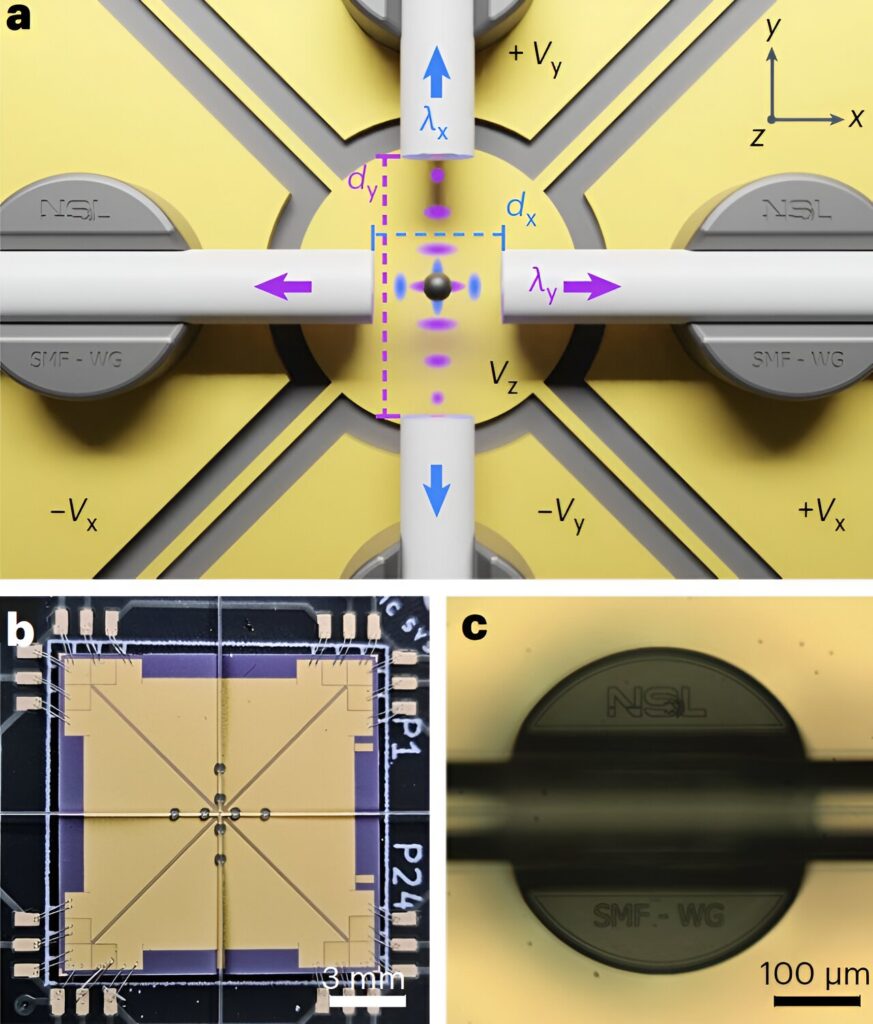The levitation of microscopic objects in vacuum and the control of their movements while they are suspended was first demonstrated several decades ago. Since then, various research groups have been working on new approaches to control levitated objects in vacuum with greater degrees of freedom.
While most experiments conducted so far relied on optical techniques, some teams have recently started using hybrid experimental platforms that combine concepts rooted in atomic physics. These hybrid platforms enable greater control over the motion of levitated objects, unlocking new possibilities, such as force and torque sensing or precision acceleration.
Researchers at ETH Zurich recently demonstrated the high vacuum levitation of a silica nanoparticle on a hybrid photonic-electric chip. Their proposed experimental platform, outlined in a paper published in Nature Nanotechnology, was found to enable robust levitation, precise position detection and dynamic control of the nanoparticle in vacuum.
“By isolating from the environment and precisely controlling mesoscopic objects, levitation in vacuum has evolved into a versatile technique that has already benefited diverse scientific directions, from force sensing and thermodynamics to materials science and chemistry,” Bruno Melo, Marc T. Cuairan and their colleagues wrote in their paper.
“It also holds great promise for advancing the study of quantum mechanics in the unexplored macroscopic regime.”
Despite recent advancements in vacuum levitation and motion control of particles, most previously introduced experimental methods rely on complex strategies and/or bulky equipment. This significantly limits their real-world applications, making them impractical for the development of new technologies.
Some researchers have thus been trying to miniaturize vacuum levitation platforms using electrostatic and optical traps. The levitation achieved using most of their proposed approaches, however, was not robust enough to be applied to confined devices, such as cryostats and portable devices.
Melo, Cuairan and his collaborators introduced a new hybrid photonic-electric platform that enables robust levitation, position detection and dynamic control of a nanoparticle on-chip. In contrast with other platforms, their proposed method does not require bulky lenses and optical equipment.
“We show levitation and motion control in high vacuum of a silica nanoparticle at the surface of a hybrid optical–electrostatic chip,” Melo, Cuairan and their colleagues wrote. “By combining fiber-based optical trapping and sensitive position detection with cold damping through planar electrodes, we cool the particle motion to a few hundred phonons.”
In initial tests, the team’s proposed on-chip vacuum levitation and motion control platform achieved remarkable results, with signal-to-noise ratios and optical displacement detection capabilities comparable to those of other approaches that rely on bulky optical equipment. When they combined their platform with planar electrodes for active feedback cooling, the researchers were also able to cool down the silica nanoparticle and reduce its motion in 3D
The new approach for on-chip vacuum levitation and motion control introduced by this team at ETH Zurich could soon open new opportunities for quantum research and technology development. In their next studies, Melo, Cuairan and their colleagues plan to continue improving their platform, for instance, using refractive microlenses to further enhance its detection sensitivity and integrating more sophisticated optical elements (e.g., fiber cavities).
“We envisage that our fully integrated platform is the starting point for on-chip devices combining integrated photonics and nanophotonics with precisely engineered electric potentials, enhancing control over the particle motion towards complex state preparation and read-out,” Melo, Cuairan and their colleagues wrote.


